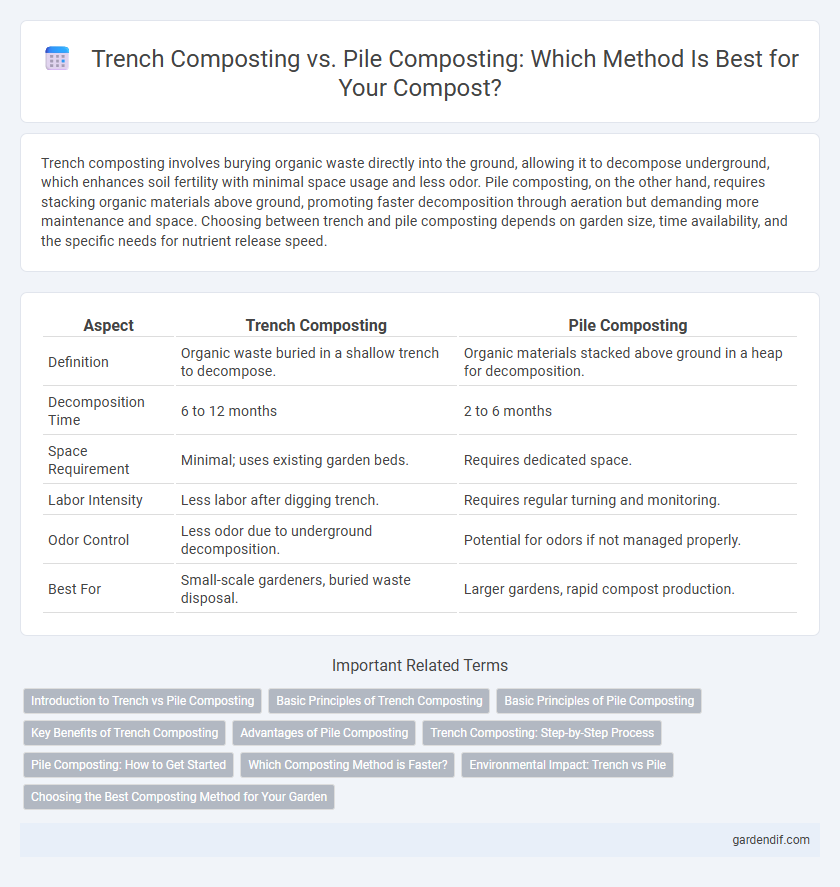
Trench composting vs Pile composting Illustration
Trench composting involves burying organic waste directly into the ground, allowing it to decompose underground, which enhances soil fertility with minimal space usage and less odor. Pile composting, on the other hand, requires stacking organic materials above ground, promoting faster decomposition through aeration but demanding more maintenance and space. Choosing between trench and pile composting depends on garden size, time availability, and the specific needs for nutrient release speed.
Table of Comparison
| Aspect | Trench Composting | Pile Composting |
|---|---|---|
| Definition | Organic waste buried in a shallow trench to decompose. | Organic materials stacked above ground in a heap for decomposition. |
| Decomposition Time | 6 to 12 months | 2 to 6 months |
| Space Requirement | Minimal; uses existing garden beds. | Requires dedicated space. |
| Labor Intensity | Less labor after digging trench. | Requires regular turning and monitoring. |
| Odor Control | Less odor due to underground decomposition. | Potential for odors if not managed properly. |
| Best For | Small-scale gardeners, buried waste disposal. | Larger gardens, rapid compost production. |
Introduction to Trench vs Pile Composting
Trench composting involves burying organic waste directly into shallow trenches, allowing decomposition to occur underground and enhancing soil fertility with minimal space usage. Pile composting, in contrast, stacks organic materials on the surface to decompose aerobically, facilitating faster breakdown through regular turning and aeration. Both methods promote nutrient recycling but differ significantly in labor intensity, odor control, and efficiency based on environmental conditions and composting goals.
Basic Principles of Trench Composting
Trench composting involves burying organic waste directly into a dug trench or hole, allowing decomposition underground to enrich the soil naturally. This method reduces surface exposure to pests and odors while promoting efficient nutrient recycling by keeping the material moist and aerated in situ. Compared to pile composting, trench composting requires less maintenance and space, making it ideal for small gardens and sustainable soil improvement.
Basic Principles of Pile Composting
Pile composting involves layering organic waste materials in a designated area, allowing natural microbial processes to break down the matter over time. This method requires maintaining optimal moisture, aeration, and temperature to accelerate decomposition and produce nutrient-rich compost. Unlike trench composting, pile composting allows easier access for turning and monitoring, facilitating efficient oxygen flow and uniform breakdown of materials.
Key Benefits of Trench Composting
Trench composting offers key benefits such as reduced pest attraction and minimal maintenance by burying organic waste directly into the soil, enabling faster decomposition and nutrient absorption. It improves soil aeration and moisture retention while minimizing odor issues compared to pile composting. This method is space-efficient and integrates composting seamlessly into garden beds, enhancing plant growth and soil health.
Advantages of Pile Composting
Pile composting offers superior aeration and easier management by allowing regular turning and moisture control, which accelerates decomposition compared to trench composting. It also accommodates larger volumes of organic waste, making it ideal for gardeners and farmers aiming for substantial compost production. The surface exposure in pile composting promotes faster breakdown of materials, resulting in nutrient-rich compost ready for use in shorter timeframes.
Trench Composting: Step-by-Step Process
Trench composting involves digging a narrow, deep trench approximately 12-18 inches wide and 12-24 inches deep, where organic waste such as kitchen scraps and garden clippings are directly deposited. After placing the waste, cover it with soil to minimize odors and deter pests while promoting anaerobic decomposition. This method accelerates nutrient recycling by allowing microorganisms to break down the material in situ, enriching soil fertility and improving structure over time.
Pile Composting: How to Get Started
Pile composting involves stacking organic waste in a designated area, allowing natural decomposition through microbial activity. To get started, select a well-drained spot with good air circulation, layer green (nitrogen-rich) and brown (carbon-rich) materials, and maintain moisture by watering regularly. Turning the pile every few weeks speeds up decomposition and helps produce nutrient-rich compost for garden use.
Which Composting Method is Faster?
Trench composting typically accelerates decomposition by directly burying organic waste in soil, enhancing microbial activity through consistent moisture and temperature conditions. Pile composting can take longer due to the need for regular turning and managing heat and aeration to maintain optimal microbial growth. Overall, trench composting usually results in faster composting because the soil environment naturally supports quicker breakdown of materials.
Environmental Impact: Trench vs Pile
Trench composting minimizes odor and pest attraction by burying organic waste directly in the soil, enhancing microbial activity and reducing greenhouse gas emissions compared to pile composting. Pile composting, while faster in breaking down materials, can release more methane and leachate if not managed properly, posing risks to air and water quality. The environmental impact of trench composting is generally lower, promoting soil health and carbon sequestration more effectively than pile composting methods.
Choosing the Best Composting Method for Your Garden
Trench composting efficiently enriches soil by burying organic waste directly in garden beds, promoting faster nutrient absorption and minimal space use, ideal for small or vegetable gardens. Pile composting suits larger spaces, allowing for better aeration and faster decomposition through regular turning, making it perfect for gardeners with abundant organic material. Selecting between trench and pile composting depends on garden size, available organic waste, and desired composting speed to maximize soil fertility and plant health.
Trench composting vs Pile composting Infographic

 gardendif.com
gardendif.com